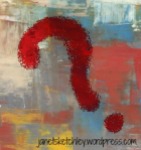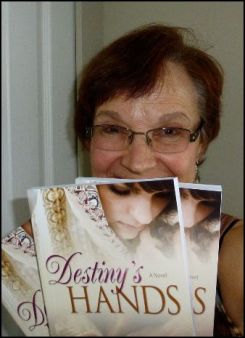 Carole Brown’s novel, The Redemption of Caralynne Hayman, released in October, and this is our chance to find out more about the story and its author.
Carole Brown’s novel, The Redemption of Caralynne Hayman, released in October, and this is our chance to find out more about the story and its author.
Janet: Welcome, Carole, and thanks for taking time to join us. Your novel’s tag line asks “How far would you go to avenge your daughter’s murder?” Definitely an attention-getter! Caralynne Hayman is the grieving mother? Can you tell us a bit about what happened to her daughter?
Carole: I’ll be glad to. Caralynne Hayman, raised in The Children of Righteous Cain, a misguided, evil cult, was married to a man who abused her and considered her property. She never loved him, but birthed three daughters whom she loved with all her heart. When her oldest daughter is abused—and dies from it—by her brother-in-law, she knows she can’t let it go. She can endure the abuse for herself, but never for her daughters. She sets out on the path of revenge and having never been taught or experienced any sense of real Christianity, she succeeds to a certain degree.
Janet: So I expect Caralynne is dealing with anger, bitterness, and unforgiveness, etc. on top of the heavy sorrow. What other issues are stacked against her?
Carole:
- The leader of the group–Elder Simmons–sets strong limitations (to keep everyone in check from too much independence) especially on the women, who are given so many hours per month to use for visits, shopping, etc. Because of her caring heart, Caralynne is always seeking ways to get around this to help her friends or to give her daughters an undocumented outing.
- Elder Simmons and his group have their own lawman–a deputy sheriff–who overlooks certain crimes for “favors.” This encourages the outside law enforcement to ignore the group, thinking the deputy will call for help if and when needed. Unfortunately, this corrupt man doesn’t do that.
- Being a naturally strong and independent woman has kept Caralynn alive although it’s also caused her to reap more abuse than normal. What the elders within the group call sassiness and slyness, Dayne (the minister and her champion) calls wit and smart thinking.
- Plus her own plot of revenge brings everything to a head.
I won’t reveal more right now as I don’t want to spoil anything for readers, but suffice it to say: Caralynne runs full tilt into almost more than she can handle and definitely more than she bargained for.
Janet: She definitely has a lot of things stacked against her! What genre is this story, Carole? And who’s your ideal reader?
Carole: It’s women’s fiction with strong elements of suspense and romance. Women will enjoy it if they like novels with strong issues and plenty of suspense. But I’ve also received endorsements and comments from men who’ve enjoyed the book too. I’d say those who’ve gone through abuse, those who’ve known family and friends who’ve suffered from it, and/or those who have a sympathetic heart toward hurting people will find this book an excellent reading choice.
And just as an added encouragement: I’ve received reviews from those who’ve been hesitant about reading it because of the tough subject, but once into the book, find they can not put it down. Give it a chance! 🙂
Janet: Where did the story idea come from?
Carole: My husband. We read and talk together over interesting tidbits of news items. When we read/heard about the cult in Texas some time ago, he came up with the idea of a woman who rebels against a cult. The plot developed from there.
Janet: You’ve written other stories as well. Is there a sequel to The Redemption of Caralynne Hayman in the works?
Carole: I think so. I don’t have a “for sure” title yet, only a working title which is “The Revenge of Elder Simmons.” J Here’s a blurb similar to what it will be about:
It begins with a baby kidnapping. Elder Simmons, the antagonist, will not let go. He is determined to wreak vengeance upon the MacFarlands, even if he has to do it from prison.
Cara and Dayne, now happily married, go through trials that will shatter their self-complacency and test their love. Dayne will be lied about and like Joseph in the Bible must hold steady for God’s timing. Cara has suffered hurts and abuse from her former marriage. With Dayne she thought everything would be smooth sailing. But when the lies surface, can she trust him, does she love him enough to stay strong for his sake? Will her mustard seed faith grow or be uprooted?
And while we’re talking about other stories, let me put in a quick plug for a mystery that is releasing this fall too. It’s called Hog Insane (and no, it’s not about pigs! J) It’s the first book in a series, introducing the characters Denton and Alex Davies and their Jack Russell, Taffy. A fun mystery that is very much different than The Redemption of Caralynne Hayman.
Janet: You’re a busy writer! You described The Redemption of Caralynne Hayman as “a passionate book, not for the weak hearted, but for those who want to be reminded, touched, and stirred.” What one key thing do you want readers to take away when they’re done?
Carole: Sympathy for the hurting. So many times we become impatient with those who we think of as ignorant or careless in “getting out” of abusive situations. Yet the people caught in these situations are caught in them by the brainwashing of either a single person, and family or even sometimes a religious (or nonreligious) group. The more the “leader” gains in power, the more he wants and strives to prevent any break in the system. The leader feeds his “subjects” on a steady diet of fear, accusations of lack of love and trust in their partner/leader, and/or the thought that the “subject” is failing in the right perception.
Janet: I’ve seen some positive early reviews. What has reader response been like for this book?
Carole: Excellent. It does deal with a tough subject but I honestly believe if those who are timid in approaching the subject in the book will read it through, they will realize the encouragement it provides. Perhaps it will even stir hearts to change their idea or thoughts pertaining to abuse or give a greater occasion for sympathy.
Janet: Caralynne and her struggle sort of upstaged you at the start of this interview. How about returning next week to introduce us to Carole Brown?
Carole: I can do that! 🙂
Janet: Great! In the mean time, readers looking for more can find an interview with Carole’s character, Caralynne Hayman, at Wordsmith Woman.
~~~
The Redemption of Caralynne Hayman, by Carole Brown
A novel of hope shining through the darkness. Contemporary women’s fiction with strong elements of suspense and romance, of particular interest to anyone who has been abused or for those dealing with abusive situations.













